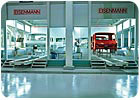Beyond Clean Air
Cleanrooms for plastic finishing systems are moving beyond simply providing contaminant-free air to the paint process and are also providing a healthy, pleasant environment for workers and visitors.

Automotive and plastic paint finishing have been the principle drivers in the growth of cleanroom technology in the finishing industry. Manufacturers of systems for these markets have been leading the way with innovative designs. New concepts are providing clean air to the finishing equipment, as well as healthy, pleasant environments in many other areas of the process. Enhanced worker productivity and customer interface with the paint process is a major area of interest in today’s cleanroom designs.
Airflow is the next critical component in the design process. A laminar flow design is essential to achieving the most efficient solution for the process. In vertical laminar designs, supply air is sent though HEPA filters in a given area, moving in one direction at a uniform speed. The speed involved is expressed in feet per minute (fpm); an approximate range for Class 100 areas with laminar flow is 70 to 120 fpm. This speed is accomplished by incorporating a filter ceiling within the given space or equipment and producing a uniform downward flow of HEPA filtered air over and around the parts being finished. The air is then exhausted through low wall or floor level returns. With this method, a high level of particulate control is established, and part contamination is avoided. The paint spray booths, flash tunnels and, most importantly, the ovens in the finishing system should all incorporate the laminar flow principle to maintain a uniform level of extreme cleanliness throughout the paint application and curing process.
In addition to the paint application process, the areas directly adjacent to the paint process equipment - typically referred to as the “cleanrooms” - should also be engineered for cleanliness. These rooms house the process controls and can be readily accessed by personnel for maintenance and operational control of the paint process. For these areas, a Class 1,000 cleanliness is required. Such rooms are generally designed using random airflow principles, in which HEPA air filters are randomly located in the room ceiling and provide an efficient general distribution of clean supply air at speeds of 25 to 35 fpm. The air is exhausted through low wall or floor level returns. A dedicated air system independent of the process equipment should be used. Entry into this cleanroom area should be additionally protected by air shower vestibules that use high-velocity HEPA filtered air to “shower” the occupant to remove particulate and then exhaust the air through filtered floor grids in a continuously recirculating system.

This type of construction also allows the designer to provide an external observation walkway along the outside wall of the cleanroom. Such a walkway can permit visitors to view the finishing operation without interfering with the operation or disturbing the clean environment. This walkway can also be enclosed to provide visitors with the same clean, comfortable environment as the finishing operators’ cleanroom. The use of glass wall construction can be expanded beyond external Class 1,000 cleanrooms to the paint spray booth and inspection tunnels.
In addition to enhancing the work environment, glass wall construction also provides other benefits. For example, the tempered glass wall panels provide an extremely smooth surface that can be easily cleaned. Additionally, the glass will not degenerate and produce contaminants that can become airborne and cause maintenance concerns for the paint system.
In some designs, tempered glass is used in conjunction with extruded aluminum profiles to create a modular cleanroom space that maximizes worker/visitor visibility while also providing aesthetic appeal and a flexible work environment. Damaged glass panels or aluminum profile covers can be replaced easily without the need for an extensive wall teardown. A modular design also allows for easy expansion or rearranging as the needs of the facility change over time.

Automotive and plastic paint finishing have been the principle drivers in the growth of cleanroom technology in the finishing industry. Manufacturers of systems for these markets have been leading the way with innovative designs. New concepts are providing clean air to the finishing equipment, as well as healthy, pleasant environments in many other areas of the process. Enhanced worker productivity and customer interface with the paint process is a major area of interest in today’s cleanroom designs.
First the Basics: Cleaning the Air
One of the first considerations to evaluate in clean air design for paint system process equipment involves classification requirements and associated airflow design. For the paint application processes associated with plastic finishing, a minimum Class 100 cleanliness is required. This means that no more than 100 particles larger than 0.5 microns can exist in any given cubic foot of air. (Class 1,000 means no more than 1,000 particles, etc.) To achieve this level of clean air filtration, high-efficiency particulate air (HEPA) filters are required. Typically, HEPA filtration can intercept 99.99% of particles as small as 0.3 micron.Airflow is the next critical component in the design process. A laminar flow design is essential to achieving the most efficient solution for the process. In vertical laminar designs, supply air is sent though HEPA filters in a given area, moving in one direction at a uniform speed. The speed involved is expressed in feet per minute (fpm); an approximate range for Class 100 areas with laminar flow is 70 to 120 fpm. This speed is accomplished by incorporating a filter ceiling within the given space or equipment and producing a uniform downward flow of HEPA filtered air over and around the parts being finished. The air is then exhausted through low wall or floor level returns. With this method, a high level of particulate control is established, and part contamination is avoided. The paint spray booths, flash tunnels and, most importantly, the ovens in the finishing system should all incorporate the laminar flow principle to maintain a uniform level of extreme cleanliness throughout the paint application and curing process.
In addition to the paint application process, the areas directly adjacent to the paint process equipment - typically referred to as the “cleanrooms” - should also be engineered for cleanliness. These rooms house the process controls and can be readily accessed by personnel for maintenance and operational control of the paint process. For these areas, a Class 1,000 cleanliness is required. Such rooms are generally designed using random airflow principles, in which HEPA air filters are randomly located in the room ceiling and provide an efficient general distribution of clean supply air at speeds of 25 to 35 fpm. The air is exhausted through low wall or floor level returns. A dedicated air system independent of the process equipment should be used. Entry into this cleanroom area should be additionally protected by air shower vestibules that use high-velocity HEPA filtered air to “shower” the occupant to remove particulate and then exhaust the air through filtered floor grids in a continuously recirculating system.

The use of tempered glass in cleanroom designs greatly increases worker visibility and subsequently increases productivity.
The Work Environment Matters
Designs being used by some facilities for the Class 1,000 cleanrooms adjacent to their paint process incorporate tempered glass wall construction. The use of glass in cleanroom designs greatly increases worker visibility and subsequently increases productivity. Workers have a more open atmosphere in which to perform their tasks and naturally feel more at ease in this type of environment.This type of construction also allows the designer to provide an external observation walkway along the outside wall of the cleanroom. Such a walkway can permit visitors to view the finishing operation without interfering with the operation or disturbing the clean environment. This walkway can also be enclosed to provide visitors with the same clean, comfortable environment as the finishing operators’ cleanroom. The use of glass wall construction can be expanded beyond external Class 1,000 cleanrooms to the paint spray booth and inspection tunnels.
In addition to enhancing the work environment, glass wall construction also provides other benefits. For example, the tempered glass wall panels provide an extremely smooth surface that can be easily cleaned. Additionally, the glass will not degenerate and produce contaminants that can become airborne and cause maintenance concerns for the paint system.
In some designs, tempered glass is used in conjunction with extruded aluminum profiles to create a modular cleanroom space that maximizes worker/visitor visibility while also providing aesthetic appeal and a flexible work environment. Damaged glass panels or aluminum profile covers can be replaced easily without the need for an extensive wall teardown. A modular design also allows for easy expansion or rearranging as the needs of the facility change over time.
Advanced Solutions
Cleanroom technology has become an integral part of finishing system design. However, many plants are moving beyond simply cleaning the air and are demanding a better environment for both their workers and visitors. Technologies such as advanced filtration and airflow, glass wall construction and modular glass wall panels can help facilities meet their objectives and achieve a state-of-the-art finishing operation.Looking for a reprint of this article?
From high-res PDFs to custom plaques, order your copy today!




